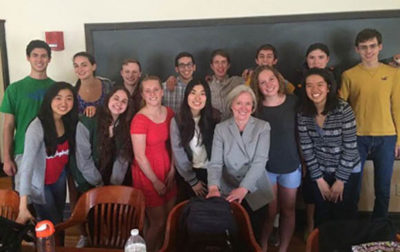Young scientists in training are the future of the biomedical research enterprise. Medical and doctoral students and clinical and postdoctoral fellows carry out much of the experimental work in labs, and they devise some of the most creative solutions to research questions.

Former president of Princeton Univeristy, Shirley Tilghman, with students
Today, these young scholars face many career challenges — difficulties securing their own independent research funding, prolonged training periods, substantial loans from medical school tuitions, gender bias, and limited opportunities for training about careers outside academia. Finding solutions to these obstacles and inspiring young scientists to achieve their full potential, think creatively, and take risks is imperative for the future success of biomedical research.
For this newsletter, we asked early-career scholars to share their perspectives on some of these issues. We spoke with Beth Kozel, a physician-scientist at the US National Institutes of Health (NIH) and a Lasker/NIH Clinical Research Scholar, and David Ottenheimer, the 2016 Lasker Essay Contest winner and a PhD student at Johns Hopkins University. We also interviewed established leaders in the biomedical field — Shirley Tilghman, president emertia of Princeton University and a mammalian developmental geneticist, who is renowned for promoting the careers of young scientists and for her national leadership on behalf of women in science, and Elizabeth Neufeld, a 1982 Albert Lasker Clinical Medical Research Award winner and a longtime chair of the University of California, Los Angeles Department of Biological Chemistry.
Our interviewees agreed that one of the big obstacles that impede young scientists from pursuing productive and creative careers is lack of adequate funding opportunities. In her interview, Elizabeth Neufeld acknowledges that the research environment was easier for young scientists 20 years ago, while today “the competition is fierce [and] the funds are tight.” David Ottenheimer expresses hope that “society will continue to understand the importance of supporting creative individuals,” pointing out that at the 2016 Lasker Award ceremony many of the laureates credited their scientific success to the freedom of pursuing innovative approaches.
Funding is not the only challenge young scientists face today. Tilghman believes that the scientific leadership “has not been willing to look hard at the experiences of young investigators” and to ask what aspects of the research enterprise are making it more challenging for young people to start their independent careers, and to be creative and successful. Beth Kozel, addressing the length of the physician-scientist training period, which currently takes up many creative years, proposed reforms that would “streamline the whole program, combining college with MD/PhD training.”
In addition to the obstacles that all young scientists need to overcome, women face additional challenges. Today, almost half of the medical degrees and doctorates in life sciences are awarded to women, yet they are still underrepresented in leadership positions. Women scientists too often get paid less, win fewer grants, and are invited less frequently to be speakers at scientific meetings and conferences. Addressing gender bias is one key solution. This is no small feat to achieve, as the present issues can be subtle and therefore challenging to tackle. As Tilghman points out: “the challenge today is that the ability to be overt has been greatly suppressed, but now we have to contend with something that is much more difficult — unconscious bias.”
Providing time and funds for childrearing is another needed reform that can help many women attain their career goals. “The degree to which our workplaces make it hard to imagine combining a very successful scientific career with having a family is still a large barrier in a woman’s career,” says Tilghman. Kozel affirms that having mentors who were willing to offer flexible working hours allowed her to have time at home with her family and the time she needed to meet her goals at work. “This is how I run my lab,” she asserts.
In addition to discussing career challenges, our interviewees shared with us their thoughts on what inspired them to pursue research, the satisfaction they find in administrative positions, and why communicating science to the public is important. We invite you to read the interviews to find out more. As always, your comments and questions are welcome.
Email: info@laskerfoundation.org
